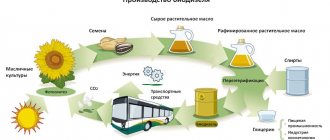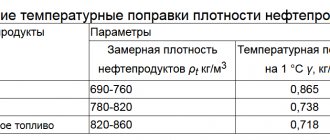The density of gasoline and other fuels is its specific gravity, namely the amount of mass per unit volume.
The density of the fuel largely depends on the density of the oil from which it is obtained. According to GOST R 52368-2005, the fuel density at a temperature of +15 °C should be in the range of 0.820-0.845 g/cm3, and according to GOST 305-82 it should not exceed 0.860 (at 20 °C)
The density of the fuel depends on the temperature, however, as for any other liquid: as the temperature increases, the density of the oil product decreases and vice versa - as the temperature decreases, the density increases. There are special tables for recalculating fuel density depending on temperature. For diesel fuel, the temperature correction for density changes is, on average, 0.0007 g/cm3 per 1°C.
Also see the table density of liquids
Density of diesel fuel at 20 degrees
The specific gravity of diesel fuel at 20 degrees is an accurate and real value. It is in this state of the liquid that the numerical expression of the specific density will be as adequate as possible. Also, at +20 degrees it is possible to objectively assess the quality properties of the product. A good density indicator indicates that the diesel fuel does not contain excess water vapor and heavy fractional hydrocarbons, which prevent rapid ignition of the liquid during ignition and increase fuel consumption while driving.
#Diesel fuel
Density of diesel fuel depending on temperature
Temperature effects are also important for diesel fuel. Therefore, to obtain correct measurement data, a standard temperature must be set. Relative to diesel, the value is +20 degrees Celsius.
The higher the temperature of the composition, the greater its density. Diesel, being a product of oil refining, is determined by the physical properties that the original raw material has. This means that the thermal dependence of this type of fuel cannot initially be neutralized. That is why summer and winter diesel fuel is available for sale, maximally adapted to the respective climatic conditions. In this case, the consumption of a liquid product with a lower density will be greater.
How to calculate the density of petroleum products
When there is no special device, then calculations should be made based on the information in the product passport and the indicators in the table of average temperature corrections. To obtain the necessary data, it is enough to perform the following basic calculations:
- In the documentation we find its density indicator at +20 Celsius.
- We measure the temperature of the product.
- We calculate the difference between the obtained result and +20 Celsius.
- Round the resulting value to a whole number.
- In the table we find the correction for deviations in accordance with the passport value at +20 Celsius.
- We calculate the product of the correction for the temperature difference.
- We combine the result with the passport value of density at +20 or subtract it if the temperature is higher.
There is nothing complicated. All mathematical operations are a school curriculum; there is no need to resort to laboratory research.
State standards applicable to gasoline
Until the end of the nineties, the production of petroleum products in Russia, in particular the production of gasoline, was regulated by GOST 2084 and TU 38.001165. These standards regulated the production of gasoline grades from A 76 to AI 96 based on their octane number. At that time, the global fuel industry was rapidly developing, cars had powerful engines, and issues of ecology and environmental protection were just beginning to be raised by individual countries. Accordingly, little attention was paid to environmental fuel standards.
Later, outdated GOSTs, along with technological progress, were replaced by newer quality standards that meet modern environmental requirements. Thus, in 1999, GOST R 51105-97 was introduced, regulating the compliance of gasoline with the requirements of the EURO 2 standard. However, in Europe at this time the issue of environmental protection became increasingly relevant. Already in 2000, a more modern environmental quality standard, EURO 3, was introduced in Europe, significantly reducing the permissible levels of metal compounds, including heavy metals, in gasoline.
Following European environmental standards, in Russia, on July 1, 2002, a new standard GOST R 51866-2002 (EH 228-2004) was adopted. This standard has already applied to the brands of high-quality high-octane gasoline Premium Euro 95 and Super Euro 98, as well as their types.
A few years later in the European Union, the EURO 3 standard was replaced by the new environmental standard EURO 4. Following this, in Russia, on January 1, 2015, GOST 32513-2013 and TU 0251-001-12150839-2015 were adopted. Both of these documents set quality standards for modern gasoline, with an octane number of at least 80 according to the research method.
After the introduction of the new EURO 5 standard, environmental requirements for fuel quality have become significantly stricter. In Russia, the EURO 5 standard was adopted on January 1, 2016. In fact, currently all imported cars imported into Russia and the fuel produced comply with this standard. Today, technical regulations regulate more than twenty characteristics of gasoline, including the proportion of benzene, which increases the octane number of gasoline, but causes significant harm to the environment. In addition, in accordance with EURO 5 requirements, gasoline is not allowed to contain metal-containing components that form toxic compounds and seriously affect the environment.
This is interesting: How to correctly calculate the fuel consumption rate
Density of diesel fuel: table
For convenience, we provide a comparative table of the main properties of various types of fuel, including the specific density of diesel fuel kg/m3.
Table 1
Density of diesel fuel: basic values
| Name | Ambient temperature, C | Pour point, C | Flash point, C | Maximum density, kg/m3 |
| Summer diesel | From 0 and above | -5 | 62 | 860 |
| Winter diesel | Up to -25 | -35 | 40 | 840 |
| Arctic diesel | Up to 50 | -55 | 35 | 830 |
Density of diesel fuel depending on temperature - table for determining the density of universal-purpose petroleum products. We present it in full.
table 2
Density of diesel fuel: full values
| +1 C | +2 C | +3 C | +4 C | +5 C | +6 C | +7 C | +8 C | +9 C | +10 C | +11 C | +12 C | +13 C | +14 C | +15 C | +16 C | +17 C | +18 C | +19 C | +20 C | |
| A | 690 | 690,9 | 691,8 | 692,7 | 693,4 | 694,6 | 695,5 | 696,4 | 697,3 | 698,2 | 699,1 | 700 | 700,9 | 701,8 | 702,7 | 703,6 | 704,5 | 705,4 | 706,3 | 707,2 |
| B | 708,1 | 709 | 709,9 | 710,8 | 711,6 | 712,5 | 713,4 | 714,3 | 715,2 | 716,1 | 716,9 | 717,6 | 718,7 | 719,6 | 720,5 | 721,4 | 722,2 | 723,1 | 724 | 724,8 |
| C | 725,7 | 726,6 | 727,4 | 728,3 | 729,2 | 730,1 | 730,9 | 731,8 | 732,6 | 733,5 | 734,3 | 735,2 | 736,1 | 736,9 | 737,8 | 738,6 | 739,5 | 740,3 | 741,2 | 742,01 |
| D | 742,9 | 743,7 | 744,5 | 745,4 | 746,2 | 747,1 | 747,9 | 748,8 | 749,6 | 750,5 | 751,3 | 752,1 | 753 | 753,8 | 754,6 | 755,5 | 756,3 | 757,1 | 757,9 | 758,8 |
| E | 759,6 | 760,4 | 761,3 | 762,1 | 762,9 | 763,7 | 764,5 | 765,3 | 766,2 | 767 | 767,8 | 768,6 | 769,4 | 770,3 | 771,1 | 771,9 | 772,7 | 773,5 | 774,3 | 775,1 |
| F | 775,9 | 776,7 | 777,5 | 778,3 | 779,1 | 779,9 | 780,7 | 781,5 | 782,3 | 783,1 | 783,9 | 784,7 | 785,5 | 786,3 | 787 | 787,8 | 788,6 | 789,4 | 790,2 | 791 |
| G | 791,8 | 792,5 | 793,3 | 794,1 | 794,9 | 795,7 | 796,4 | 797,2 | 798 | 798,8 | 799,5 | 800,3 | 801,1 | 801,9 | 802,6 | 803,4 | 804,2 | 804,9 | 805,7 | 806,4 |
| H | 807,2 | 808 | 808,7 | 809,5 | 810,3 | 811 | 811,8 | 812,5 | 813,3 | 814 | 814,8 | 815,5 | 816,3 | 817 | 817,8 | 818,5 | 819,3 | 820 | 820,8 | 821,5 |
| I | 822,3 | 823 | 823,7 | 824,5 | 825,4 | 826 | 826,7 | 827,4 | 828,2 | 828,9 | 829,6 | 830,4 | 831,1 | 831,8 | 832,6 | 833,3 | 834 | 834,7 | 835,5 | 836,2 |
| J | 836,9 | 837,6 | 838,4 | 839,1 | 839,8 | 840,5 | 841,2 | 841,9 | 842,7 | 843,4 | 844,1 | 844,8 | 845,5 | 846,2 | 846,9 | 847,6 | 848,3 | 849,1 | 849,8 | 850,5 |
| K | 851,2 | 851,9 | 852,6 | 853,3 | 854 | 854,7 | 855,4 | 856,1 | 856,8 | 857,5 | 858,2 | 858,9 | 859,6 | 860,3 | 861 | 861,6 | 862,3 | 863 | 863,7 | 864,4 |
| L | 865,1 | 865,8 | 866,6 | 867,1 | 867,8 | 868,5 | 869,2 | 869,9 | 870,5 | 871,2 | 871,9 | 872,6 | 873,2 | 873,9 | 874,6 | 875,3 | 875,9 | 876,6 | 877,3 | 877,9 |
| M | 878,6 | 879,3 | 880 | 880,6 | 881,3 | 881,9 | 882,6 | 883,3 | 883,9 | 884,6 | 885,2 | 885,9 | 886,6 | 887,2 | 887,9 | 888,5 | 889,2 | 889,9 | 890,5 | 891,1 |
| N | 891,8 | 892,5 | 893,1 | 893,8 | 894,4 | 895 | 895,7 | 896,3 | 897 | 897,6 | 898,3 | 898,9 | 899,6 | 900,2 | 900,9 | 901,5 | 902,1 | 902,8 | 903,6 | 904 |
| O | 904,7 | 905,3 | 905,9 | 906,6 | 907,2 | 907,9 | 908,4 | 909,1 | 909,7 | 910,3 | 911 | 911,6 | 912,2 | 912,8 | 913,4 | 914,1 | 914,7 | 915,3 | 915,9 | 916,5 |
| P | 917,2 | 917,8 | 918,4 | 919 | 919,6 | 920,3 | 920,9 | 921,5 | 922,1 | 922,7 | 923,3 | 923,9 | 924,5 | 925,1 | 925,7 | 926,3 | 926,9 | 927,5 | 928,1 | 928,8 |
| Q | 929,4 | 930 | 930,6 | 931,2 | 931,7 | 932,3 | 932,9 | 933,5 | 934,1 | 934,7 | 935,3 | 935,9 | 936,5 | 937,1 | 937,7 | 938,3 | 938,9 | 939,5 | 940,1 | 940,6 |
| R | 941,2 | 941,8 | 942,4 | 943 | 943,6 | 944,1 | 944,7 | 945,3 | 945,9 | 946,5 | 947 | 947,6 | 948,2 | 948,8 | 949,4 | 949,9 | 950,5 | 951,1 | 951,6 | 952,2 |
| S | 952,8 | 953,3 | 953,9 | 954,5 | 955 | 955,6 | 956,2 | 956,7 | 957,3 | 957,9 | 958,4 | 959 | 959,6 | 960,1 | 960,7 | 961,3 | 961,8 | 962,4 | 962,9 | 963,5 |
| T | 964 | 964,6 | 965,1 | 965,7 | 966,2 | 966,8 | 967,4 | 967,9 | 968,5 | 969 | 969,6 | 970,1 | 970,7 | 971,2 | 971,7 | 972,3 | 972,8 | 973,4 | 973,9 | 974,4 |
| U | 975 | 975,5 | 976,1 | 976,6 | 977,2 | 977,7 | 978,2 | 978,8 | 979,3 | 979,9 | 980,4 | 980,9 | 981,4 | 982 | 982,5 | 983 | 983,6 | 984,1 | 984,6 | 985,1 |
| V | 985,7 | 986,2 | 986,7 | 987,3 | 987,8 | 988,3 | 988,8 | 989,4 | 989,9 | 990,4 | 990,9 | 991,4 | 992,2 | 992,5 | 993 | 993,5 | 994 | 994,5 | 995 | 995,5 |
It is used in cases where density measurement occurs when there is a deviation from the standard temperature. Having determined the density of the substance at the current moment in time, it is necessary to draw a horizontal parallel to a column with a temperature of +20 degrees - this will be the real density of the composition.










